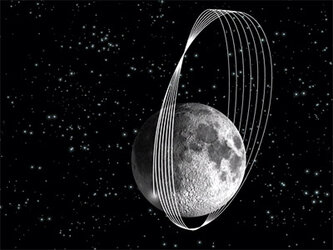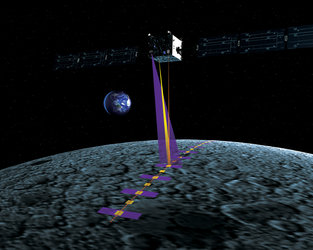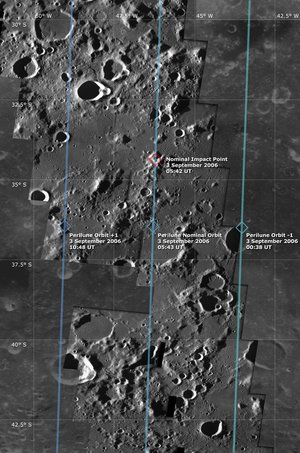SMART-1: Europe on the Moon, one year on
A year ago, as Europe reached the Moon for the first time, scientists on Earth eagerly watched SMART-1’s spectacular impact. New results from the impact analysis and from the instruments still keep coming.
One year on, we present ongoing scientific highlights of the mission. The analysis of data and simulations of the satellite’s impact provide clues on the dynamics of the ejecta after the flash, along with laboratory experiments or modelling of impacts. The experience gained is being put to good use in preparation for future missions.

SMART-1 addresses various scientific themes that answer questions on the physical processes at work on Earth-like planets and how they evolve. The moon is a laboratory for geophysics where impacts, volcanism, tectonics and effects of space weather can be studied to put together the story of its past.
The geochemistry and origins of the Moon, the evolution of the Earth-Moon system and the bombardment of the inner solar system are topics addressed under lunar formation and evolution.

Experience gained from SMART-1 is helping prepare the ground for future science and exploration missions. With its unrivalled resolution, in colour and with various illumination angles, the satellite has mapped the polar regions, surveyed lunar resources and investigated potential landing sites and outposts.
“Know-how and data from SMART-1 is forming a bridge for international collaboration and European contribution to upcoming lunar Missions," says Bernard Foing, ESA's SMART-1 Project scientist.
“After SMART-1’s final touchdown at 2 km/s, everybody asks: when will Europe land softly on the Moon?” he adds.
Read the full story on the ESA Science pages















 Germany
Germany
 Austria
Austria
 Belgium
Belgium
 Denmark
Denmark
 Spain
Spain
 Estonia
Estonia
 Finland
Finland
 France
France
 Greece
Greece
 Hungary
Hungary
 Ireland
Ireland
 Italy
Italy
 Luxembourg
Luxembourg
 Norway
Norway
 The Netherlands
The Netherlands
 Poland
Poland
 Portugal
Portugal
 Czechia
Czechia
 Romania
Romania
 United Kingdom
United Kingdom
 Slovenia
Slovenia
 Sweden
Sweden
 Switzerland
Switzerland









































